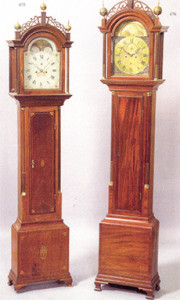In England they were long case clocks, and in America they were tall case clocks.
By any name, even the sentimental 19th century term grandfather clock, they were a majestic structure which towered over the rest of the household’s furnishings.
Their from-the-ground-up existence began in the latter 17th century in parts of Europe. By most accounts they were soon attracting attention in America as well.
Furniture historian Charles Montgomery, writing in the distinguished volume American Furniture: The Federal Period observes, “the tall case clock was then, and remained to this day, the Cadillac of clocks.”
Basically the advent of the tall case clock was simply to accommodate the long weights and eventually an equally long pendulum. Progressing to the amble pendulum caused such clocks to be expanded directly below the center of the base. Thus the case housed the essentials, and along the way, also provided protection from dust and outside damage.
It soon followed that such tall case clocks were intricately decorated with generous applications of bronze and an abundance of delicate lines.
For all of their beauty and appeal they were not for everyone in Colonial America. For one thing they were just about the most expensive item of furnishing a house could hold. And for another they were costly to maintain.
“During the 17th century, few Americans owned such clocks, and those who did had trouble keeping them running,” according to the authors of Southern Furniture, The Colonial Williamsburg Collection, “partly do to a shortage of suitable artisans.”
Research by the two, Ronald Hurst and Jonathan Prown, suggests many timepieces listed in early appraisals often described them as not working, out of order, out of kilter, and other apt phrases.
Despite the costliness and the need for continuing maintenance more and more of them were seen in 18th century. Part of this could be ascribed to the ingenuity of American-based clockmakers like Benjamin Bagnall of Boston.
Bagnall was born in England but eventually ended up in the clock trade in Colonial America. Tall clocks were imported from England early in the 18th century, but many credit Bagnall with one of the first American-made tall clocks. It was a pine case example, inside the door was written, “this clock put up Jan. 10, 1722.”
By the 1730s Bagnall was turning out other quality tall clocks. Eventually he was assisted by two of his several children, Benjamin Junior and Samuel Bagnall. Later some legendary names would be added to annals of American clock making including Simon Willard and family, Eli Terry, Seth Thomas, and Silas Hoadley.
Not surprisingly the style and grace of long case clocks varied somewhat by the skills and tastes of the maker.
One particular tall clock design between 1780 and 1820 was known as the Roxbury style. According to Montgomery and others it included open fretwork over a founded hood with three cup or urn finials of brass. In Philadelphia particularly, “inlaid geometric panels were often heavily outlines by cross-banding or patterned stringing.” These devices came as opposed to “high swan-neck pediments and many inlaid ellipses and circles” which were typical of cased made in the New Jersey region.
Decorative touches for tall case clocks came from different places. Cast ornaments were available through hardware supplies in England. Some Colonial clockmakers were known to have ordered spandrels and engraved face places from those foreign sources. Other domestic clockmakers fashioned their own, or turned to suppliers in their own city.
Replacements were quite necessary too. Finials were easily damaged and routinely replace. Likewise pediments–the gable over the clock’s portico-were often damaged and required repairs.
Typically dial hands on long case clocks were crafted from blued steel to provide a sharply contrasting over the otherwise light face of the clock. The ‘moon-lit’ face often included an actual moon discs depicting the phases of the moon just above the clock face.
While pine and similar woods were initially used in America, by the latter 18th century mahogany was the wood of choice at home and abroad. A Federal mahogany inlaid tall case might include a glazed ‘tombstone’ glass door with a gilt dial inside. Clocks of this period might have pierced fretwork joining reeded moldings, as well as the desired gilt dial showing phases of the moon.
Less frequently seen than mahogany long clock cases, were those crafted of walnut during the same latter 18th century periods. While gilt metal was frequently added early in the 19th century to such clocks, the emphasis was a inevitably on the quality an overall appearance of the distinguished wooden outside.
For many years such a distinguished tall case clock stood in the West Wing reception room of the White House. Also called the Appointments Lobby, the west wall served as background for the Hepplewhite style clock with delicate fan inlays. It was crafted in 1810 Philadelphia.
Wood, by the way, was generally not a good idea for the working parts inside. At some point there was a trend by some clockmakers to reduce costs by avoiding brass works for much less expensive wooden works. Usually such wooden works were much more subject to warping, jamming, and other ill effects from the atmosphere.
Today, not surprisingly, condition plays critical role in determining the value of a long case clock of the past.
“The highest prices for tall case clocks are realized for signed clocks in their original cases in excellent original condition,” notes Frederick Korz author of the Official Price Guide to Collecting Clocks.
Likewise lesser prices are realized for clocks with obvious troubles such as damaged cases, faulty dials or movements, poor restorations and missing parts.
“Signed tall case clocks always sell for more than comparable unsigned clocks,” concludes Korz. “Re-cased tall case movements always sell for less than movements in original cases.”
Recommended reading: Official Price Guide to Collecting Clocks by Frederick Korz, House of Collectibles.
















Follow Us